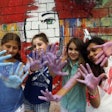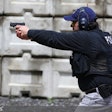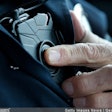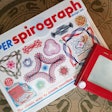Trying to do just a few quick "tips for trainers" is like trying to bail seawater out of a boat with a teaspoon—there's just too much water! This installment we'll talk about what happens before you start your class.
Tip Number 1 – Don't be on time.
That's right, don't be on time…be early! We've all had the experience of sitting in a classroom as students, waiting for the instructor to arrive. There's nothing that conveys a lack of respect for your students more than arriving late. (The occasional real emergency is permissible, but fall all over yourself apologizing!) Being early allows for unforeseen difficulties.
Being there, ready to go as the students arrive allows you to greet them in a relaxed manner as they come in. Remember, many of them don't know you, and haven't been in your classes before. Their first impression of you can absolutely make or break your day and theirs. If you appear prepared, calm, and relaxed, you will come off as professional and courteous, respectful of their time, and worthy of their attention (at least until you open your mouth; then you have to deliver).
Tip Number Two – Shuffle your papers.
Most trainers have been told not to shuffle their papers while presenting, and that's good advice. The time for shuffling your papers is before you start talking. Make sure that your notes, handouts, exhibits, and lesson plans are all accessible and where you can get to them without having to "shuffle" in front of the class.
Start your roster going around as soon as the first student sits down. Let the students manage the roster. You'll be amazed at how quickly they will take care of getting it all filled out by each member of the class.
If at all possible, distribute your manuals and other handout materials to students' seating positions before they come into the room. This will allow you time to make sure that each handout is correct and complete, and that each student has everything he or she should. This saves time, and avoids having to go through everything with the students later.
Tip Number Three – Practice situational awareness.
That's right, situational awareness. Just like you train your students to be aware of their surroundings, and to be in a constant state of "condition yellow," make sure you do the same.
Check out the entrances and exits, restroom facilities, refreshment arrangements, and smoking restrictions. Check lines of sight to your projection screen, flip chart, or white board. Make sure the entrance doors are unlocked, including the door from the hallway into your classroom. That way, when a student steps out for a personal break during class, they can re-enter unobtrusively.
Remember to check out the projection screen. If there isn't one, or if the one provided is too small for your students to see well, you'll have time to reach the host and get a replacement. Check to make sure you can control the lighting, through use of window shades and the room's light switches.
Make sure you have your cell phone, and know the location you are at well enough to give directions to a 911 operator in an emergency. If you're doing motor skill training, make sure you have adequate first-aid supplies. If it's a hot day, make sure you have plenty of liquids available.
While we're talking about temperatures, check the thermostat in your training area. Note if it's too warm or too cold, and find out how to change it or how to get in touch with someone who can. Uncomfortable temperature settings (usually too cold) are the most common negative comments on class evaluations.
While you're at it, check the weather forecast. A bad one can impact your students' ability to get to class, and might require you to allow extra travel time as well.
Tip Number Four – Do your class prep the night before, not the morning of the class.
This includes reviewing your lesson plan and PowerPoint presentation, making sure you have enough copies of handout materials and tests, and double-checking everything. Do another "proof read" of your slides. It is incredibly easy to commit a spelling or grammar error, and miss it when you do your own proofing. I have found errors in presentations that I have previously used several times. Always check again.
This is also where you check your equipment and your supplies. Pay particular attention to your safety gear, depending on what type of class you're teaching. Protective eyewear, hearing protectors, floor mats, and other safety gear are absolutely essential. Make sure you have enough, and that it's in good repair. (Note: This is where you firearms and TASER trainers need to remember to bring a few pairs of glasses that will fit over regular glasses, for those officers that can't see if they swap their glasses for your protective pair.)
Don't forget the mundane stuff. Anyone can remember extra ammo and targets when preparing for a range event. But what about cleaning gear, and a couple of spare weapons, in case one breaks down during training? How about a fresh battery for the PA system, or for the flashlights the instructors will need on the range? What about an extra extension cord, and maybe some fresh batteries for your laser pointer? The list seems endless.
And, even though your students are cops, and would never dream of going on patrol without a writing instrument and a pad of paper, for some reason they feel no compunction at all about showing up at your class with neither. Throw in a box of cheap ink pens and a few yellow pads, just in case.
Tip Number Five – Expect the unexpected.
Despite your best efforts, stuff happens. Some students won't show up, and many times extra students will. The power might go out, or the projector bulb will burn out. You might have to rearrange the room for a more effective training environment. Your computer might crash, or any one of a dozen cables might short out or break.
You can't prepare for everything. However, you can be a "training risk manager." Manage the more probable things. Carry at least two remote controls, and a backup of your presentation (along with any embedded videos) on a thumb drive or external hard drive. Bring an extra AC adapter for your computer, and a long extension cord. Throw in an extra power strip.
Bring a backup for every cable that is critical to your presentation. Usually this will mean power cords, AC adapters, USB cables, speaker cables, and a VGA cable to connect your laptop to your projector.
If you're really a worry-wart, bring a backup projector. For really important presentations (they're all important, but you know what I mean), consider bringing a backup computer.
One last thing. It's not really a training tip, as much as common sense. If you're unfamiliar with the location, get there the day before, and find the building and room. If you can get in, check out the room so you'll know what you're getting into. That way if you have a half hour of table and chair shuffling, you can do it the night before, and not while your students are trying to find a seat.
Most importantly, don't worry! Relax! If you're prepared, there's hardly anything that can go wrong!
Or maybe not…
Stay safe, and wear your vest!













